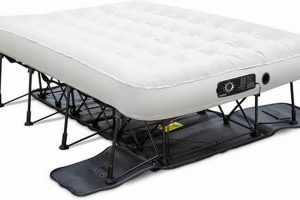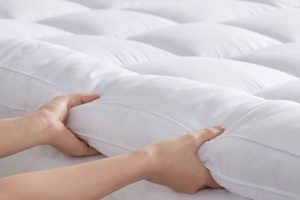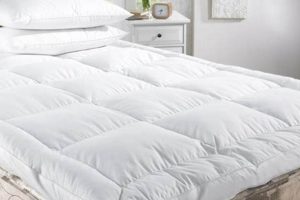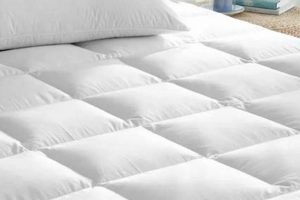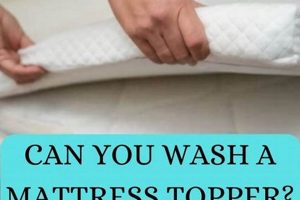A cushioning layer designed to enhance the comfort of a convertible sofa is a common addition. This accessory typically consists of foam, memory foam, or other padding materials placed atop the existing sleeping surface to mitigate discomfort arising from the inherent limitations of such furniture. As an illustration, one might add a plush layer to a pull-out sofa to improve its suitability for overnight guests.
The addition of this layer can significantly improve the sleep experience on a convertible sofa. Benefits include increased comfort, reduced pressure points, and improved spinal alignment. Historically, individuals have sought ways to enhance the functionality and comfort of multi-purpose furniture, leading to the development of these solutions.
The following sections will delve into the types of materials used in these cushioning layers, considerations for selecting an appropriate size and thickness, and strategies for maintaining and cleaning the chosen accessory.
Guidance on Selecting and Utilizing a Convertible Sofa Overlay
The following guidance aims to provide practical advice for optimizing the selection and use of an overlay intended to improve the comfort of a convertible sofa bed.
Tip 1: Material Selection: Prioritize materials based on desired comfort level and support. Memory foam provides contouring and pressure relief, while latex offers greater resilience and breathability. Consider personal preferences and any potential allergies when making this determination.
Tip 2: Thickness Considerations: The thickness of the supplementary layer directly impacts the overall comfort. A thicker layer generally provides more cushioning; however, ensure compatibility with the sofa bed’s folding mechanism. Insufficient clearance can impede proper closure.
Tip 3: Size Accuracy: Precise measurements of the convertible sofa bed’s sleeping surface are essential. The overlay should match the dimensions closely to prevent shifting and uneven support. Overhang or gaps can diminish the intended comfort enhancement.
Tip 4: Density and Support: Pay attention to the density of the chosen material. Higher density options offer greater support for individuals requiring firmer sleeping surfaces. Lower density options may be suitable for those seeking a softer feel.
Tip 5: Cover Material: Consider the cover material’s breathability and ease of cleaning. A breathable cover promotes airflow, preventing overheating during sleep. Removable and washable covers simplify maintenance and hygiene.
Tip 6: Securing the Overlay: Explore methods for securing the overlay to the convertible sofa bed. Options include elastic straps, corner anchors, or non-slip backing. Proper securement minimizes movement and ensures consistent support.
Tip 7: Storage Considerations: If the overlay is not intended for permanent use, assess its storage requirements. Opt for materials that compress easily or can be rolled compactly to minimize storage space.
Implementing these recommendations can significantly enhance the comfort and usability of a convertible sofa bed, promoting restful sleep for users.
The subsequent section will address maintenance procedures to extend the lifespan of the cushioning layer.
1. Material Composition
The composition of materials used in a surface enhancement dictates its performance characteristics when applied to a convertible sofa. The choice of material fundamentally affects the overall comfort, durability, and suitability of the accessory.
- Foam Density and Type
Foam, whether polyurethane, memory foam, or high-density variants, provides the primary cushioning layer. Density dictates the level of support and resistance to compression. Higher-density foams offer greater support and longevity but may feel firmer initially. For example, a high-density polyurethane foam may be preferable for individuals requiring substantial support, while memory foam excels in conforming to the body’s contours, providing pressure relief. The selection hinges on individual preferences and support requirements.
- Latex Variations
Latex presents an alternative to foam, derived from natural or synthetic sources. Natural latex exhibits inherent resilience, breathability, and hypoallergenic properties, rendering it suitable for individuals with sensitivities. Synthetic latex, while generally less expensive, may lack the same level of breathability and hypoallergenic qualities. The decision to utilize latex typically balances cost considerations with desired performance characteristics.
- Fiber Fill Applications
Fiber fill, often composed of polyester or cotton, can serve as a supplementary layer, enhancing surface softness and promoting airflow. While fiber fill contributes to initial comfort, it may compress over time, reducing its overall support. Fiber-filled options are usually less expensive than foam or latex and are often found in thinner, more basic surface additions.
- Cover Fabric Properties
The fabric encasing the cushioning material influences breathability, moisture management, and ease of maintenance. Natural fabrics like cotton offer good breathability but may be less resistant to staining and wear. Synthetic fabrics, such as polyester blends, can provide enhanced durability and stain resistance. The choice of cover fabric balances comfort, practicality, and aesthetic considerations.
The interplay of these materials, including core cushioning elements and encasing fabrics, determines the suitability of the product for use on a convertible sofa. Careful material selection ensures optimal comfort, support, and durability, extending the lifespan of the seating furniture and enhancing user satisfaction. The consideration of factors such as intended use, user preferences, and potential allergies is paramount in the selection process.
2. Thickness Options
The thickness of a cushioning layer is a critical determinant of its suitability for use on a convertible sofa. Insufficient thickness may provide inadequate cushioning, failing to mitigate the discomfort often associated with the underlying structure of such furniture. Conversely, excessive thickness can hinder the folding mechanism of the sofa, rendering it impractical for its intended multi-functional purpose. The optimal thickness represents a balance between comfort enhancement and operational feasibility.
Variations in thickness impact the perceived firmness and pressure relief afforded by the product. A thinner profile, generally ranging from one to two inches, may suffice for individuals seeking a slight enhancement to an already relatively comfortable sofa bed. Thicker options, extending to three or four inches, are typically pref
erred when addressing significant discomfort issues, such as pronounced springs or uneven surfaces. Selecting the appropriate thickness is contingent upon the user’s weight, preferred sleeping position, and the existing condition of the convertible sofa’s sleeping surface. For example, a side sleeper might benefit from a thicker option to alleviate pressure on the hips and shoulders, while a back sleeper might find a thinner profile adequate for spinal alignment.
Therefore, the selection of an appropriate thickness requires a careful assessment of the sofa bed’s structural characteristics and the user’s individual needs. The effectiveness of the accessory is inextricably linked to its ability to provide adequate cushioning without compromising the functional aspects of the convertible sofa. Consideration of both the tangible characteristics of the furniture and the subjective preferences of the user is essential for optimal selection. Furthermore, considering the additional weight a thicker product has is crucial.
3. Size Compatibility
Size compatibility is a fundamental attribute of any surface enhancement designed for a convertible sofa. A mismatch in dimensions directly undermines the intended benefits, potentially causing discomfort and rendering the addition ineffective. If the supplemental layer is too small, gaps will exist, creating uneven support and negating the intended cushioning effect. Conversely, an oversized layer may overhang the edges, interfering with the sofa bed’s folding mechanism and presenting a tripping hazard. Accurate measurement of the convertible sofa’s sleeping surface is thus paramount.
The impact of size compatibility extends beyond immediate comfort. An ill-fitting product is prone to shifting during use, disrupting sleep and accelerating wear and tear. Elastic straps or corner anchors, often included with these additions, can mitigate minor size discrepancies; however, they cannot compensate for substantial mismatches. For instance, a full-size addition placed on a twin-size sofa bed will inevitably bunch and fold, creating pressure points rather than alleviating them. The selection process should therefore prioritize precise dimensional alignment over perceived material quality or cost savings.
In summary, size compatibility is not merely a desirable characteristic but a prerequisite for the functional efficacy of a convertible sofa surface enhancement. Inaccurate dimensions compromise comfort, durability, and safety, negating the intended purpose of the product. Prioritizing accurate measurement and adherence to specified dimensions is essential for a successful and beneficial application. The consequences of neglecting this aspect range from compromised sleep quality to potential damage to the sofa bed’s folding mechanism.
4. Support Characteristics
The support characteristics of a surface enhancement are critical in determining its efficacy when used on a convertible sofa. The level of support provided directly influences spinal alignment, pressure distribution, and overall comfort, thereby affecting the quality of sleep experienced. The selection of appropriate support characteristics hinges on individual needs and preferences, accounting for factors such as body weight, sleeping position, and any pre-existing musculoskeletal conditions.
- Density and Firmness
Density and firmness are primary determinants of support. Higher-density materials, such as high-density foam or latex, offer greater resistance to compression, providing a firmer sleeping surface. Lower-density materials conform more readily to the body’s contours, offering a softer feel. Individuals requiring substantial support, such as those with back pain, often benefit from higher-density options, while those seeking pressure relief may prefer lower-density alternatives. For example, a high-density foam layer can maintain spinal alignment for a heavier individual, whereas a softer memory foam option can alleviate pressure points for a lighter person.
- Zoning and Targeted Support
Some surface enhancements incorporate zoning, featuring varying levels of support in different areas. For instance, a product may offer firmer support in the lumbar region and softer support in the shoulder and hip areas. This targeted approach aims to optimize spinal alignment and pressure distribution based on the body’s natural contours. Zoning can be particularly beneficial for side sleepers, who require enhanced support in specific areas to maintain proper alignment. Such features are aimed at mitigating pain and enhancing sleep quality.
- Edge Support Considerations
Edge support is a critical consideration, especially for those who tend to sleep near the edge of the sofa bed. Adequate edge support prevents the sensation of rolling off and maximizes the usable sleeping surface. Surface enhancements with reinforced edges offer greater stability and prevent sagging, ensuring consistent support across the entire surface. The absence of edge support can lead to discomfort and a restricted sleeping area.
- Material Resilience and Longevity
The resilience and longevity of the material directly impact the long-term support characteristics of the surface enhancement. Materials that degrade rapidly lose their ability to provide adequate support, necessitating frequent replacement. High-quality materials, such as durable latex or high-density foam, maintain their support characteristics over extended periods, providing consistent comfort and promoting long-term value. Lower-quality materials may initially offer adequate support but quickly lose their shape and effectiveness.
These facets highlight the importance of carefully considering the support characteristics when selecting a surface enhancement for a convertible sofa. The ideal choice aligns with individual needs, preferences, and any specific physical requirements. Prioritizing these factors ensures optimal comfort, spinal alignment, and overall sleep quality, transforming a potentially uncomfortable sofa bed into a restful sleeping surface.
5. Cover Breathability
Cover breathability is a significant factor influencing the overall comfort and usability of a surface enhancement for a convertible sofa. It dictates the rate at which air and moisture permeate the outer layer, impacting temperature regulation and the potential for bacterial growth within the cushioning material. The selection of a cover material with appropriate breathability characteristics directly contributes to a more hygienic and comfortable sleep environment.
- Material Composition and Air Permeability
The inherent air permeability of a fabric is determined by its fiber type and weave pattern. Natural fibers like cotton and bamboo rayon generally exhibit higher breathability compared to synthetic materials such as polyester. A looser weave also promotes airflow, allowing heat and moisture to dissipate more readily. For example, a surface enhancement encased in tightly woven polyester may trap heat, leading to discomfort and increased perspiration, while one covered in loosely woven cotton promotes ventilatio
n and reduces the likelihood of overheating. The choice of material should reflect a balance between durability, ease of cleaning, and breathability. - Moisture Wicking Properties
In addition to air permeability, the moisture-wicking properties of a cover fabric contribute to its breathability. Moisture-wicking materials draw perspiration away from the body, facilitating evaporation and maintaining a dry sleeping surface. Fabrics with this attribute, such as certain synthetic blends or treated natural fibers, enhance comfort by preventing the build-up of moisture that can lead to discomfort and bacterial growth. Consider, for instance, a surface enhancement designed for use in humid climates; a cover with effective moisture-wicking properties is crucial for maintaining a comfortable sleep environment.
- Impact on Temperature Regulation
The breathability of the cover directly impacts temperature regulation during sleep. A breathable cover allows excess heat to dissipate, preventing the sleeper from overheating. Conversely, a cover with poor breathability can trap heat, leading to discomfort and disrupted sleep. Individuals who tend to sleep hot may benefit from surface enhancements featuring covers made from breathable materials like cotton or bamboo. For example, the application of a surface enhancement with a breathable cover can mitigate the discomfort associated with memory foam, which is known to retain heat.
- Hygienic Considerations
Breathability plays a role in maintaining a hygienic sleep environment. Proper airflow helps to prevent the build-up of moisture, which can promote the growth of bacteria and mold. A breathable cover, combined with regular cleaning, contributes to a cleaner and healthier sleeping surface. Selecting a cover material that is both breathable and easily washable enhances hygiene and extends the lifespan of the surface enhancement. A breathable fabric minimizes the risk of allergen accumulation within the foam core.
In conclusion, cover breathability is an indispensable attribute that influences comfort, hygiene, and temperature regulation. The selection of a surface enhancement for a convertible sofa should prioritize cover materials that promote airflow and moisture management, ensuring a more restful and hygienic sleep experience. Neglecting this aspect can compromise comfort and increase the risk of microbial growth, diminishing the overall value of the product. Therefore, choosing a surface enhancement with adequate breathability is critical for maximizing its utility and promoting long-term user satisfaction.
6. Securement Method
The securement method is an integral component of a supplementary cushioning layer designed for convertible sofas, directly influencing its effectiveness and longevity. The inherent instability of a convertible sofa’s sleeping surface, compounded by the addition of a non-affixed layer, necessitates a reliable securement system. Without adequate securement, the supplementary layer is prone to shifting during use, resulting in uneven support, discomfort, and potential damage to both the added layer and the underlying sofa bed mechanism. This instability directly undermines the intended purpose of enhancing comfort and improving sleep quality. As an example, consider a foam layer placed on a pull-out sofa with no means of attachment. Each movement during sleep causes the foam to migrate, creating pressure points and negating the cushioning effect. The securement method thus acts as a stabilizing force, ensuring consistent support and maximizing the benefits of the added layer.
Various securement methods exist, each with its own advantages and limitations. Elastic straps, often attached to the corners of the layer, provide a simple and adjustable means of securing it to the sofa frame. While effective for preventing gross movement, elastic straps may not entirely eliminate minor shifting. Non-slip backing, typically composed of rubber or silicone, relies on friction to prevent movement. This method is less intrusive than straps but may lose effectiveness over time, particularly with repeated folding and unfolding of the sofa bed. Integrated fitted sheets, designed to encase both the added layer and the original mattress, offer a more comprehensive securement solution but may require precise sizing and can be more cumbersome to install. The choice of securement method depends on factors such as the type of supplementary layer, the frequency of use, and the user’s preferences. For instance, a heavier memory foam layer may require a more robust securement system, such as elastic straps combined with a non-slip backing, to prevent significant movement.
In conclusion, the securement method is not merely an ancillary feature but a critical factor in the overall performance of a supplementary cushioning layer for convertible sofas. A well-designed securement system ensures consistent support, minimizes discomfort, and extends the lifespan of the added layer. Neglecting this aspect can lead to a compromised sleep experience and a diminished return on investment. The selection of an appropriate securement method should therefore be a primary consideration, alongside material composition, thickness, and size compatibility, to fully realize the benefits of a convertible sofa surface enhancement.
Frequently Asked Questions Regarding Convertible Sofa Surface Enhancements
The following addresses common inquiries concerning the selection and utilization of surface enhancements intended to improve the comfort of convertible sofas.
Question 1: What is the typical lifespan of a convertible sofa surface enhancement?
The lifespan of such a product is contingent upon several factors, including material composition, usage frequency, and maintenance practices. High-density foam or latex models, properly maintained, can retain their supportive properties for several years. Conversely, lower-density materials or those subjected to heavy use may require more frequent replacement.
Question 2: Are all convertible sofa surface enhancements hypoallergenic?
Not all products are inherently hypoallergenic. While some materials, such as natural latex or certain synthetic fibers, possess inherent hypoallergenic properties, others may require specific treatments to mitigate allergen accumulation. Individuals with sensitivities should carefully examine product specifications to ensure suitability.
Question 3: Can a surface enhancement rectify significant structural defects in a convertible sofa?
Surface enhancements are primarily intended to improve comfort and provide supplementary support. While they can mitigate minor imperfections in the underlying structure, they are not designed to rectify significant structural defects, such as broken springs or severely damaged frames. Addressing such issues requires professional repair or replacement of the sofa itself.
Question 4: How does the weight of the surface enhancement affect the folding mechanism of the convertible sofa?
The weight of the enhancement can impact the ease of folding and unfolding the convertible sofa. Overly heavy models may strain the folding mechanism, potentially leading to damage over time. Selecting a lightweight yet supportive material is crucial for preserving the functionality of the sofa.
Question 5: What cleaning procedures are recommended for convertible sofa surface enhancements?
Recommended cleaning procedures vary depending on the material composition of the surface enhancement and its cover. G
enerally, spot cleaning with a mild detergent is advisable for minor stains. Removable covers should be laundered according to the manufacturer’s instructions. Professional cleaning may be necessary for more extensive stains or for products with delicate materials.
Question 6: Is it possible to customize a convertible sofa surface enhancement to fit unconventional sofa bed dimensions?
Customization options may be available from certain manufacturers or specialty retailers. However, bespoke solutions often entail higher costs and longer lead times. Accurately measuring the sofa bed’s dimensions and consulting with a knowledgeable vendor is essential to determine the feasibility of customization.
In summary, careful consideration of material properties, maintenance practices, and the inherent limitations of surface enhancements is essential for making informed decisions and maximizing the benefits of these products.
The next segment addresses case studies involving applications of surface enhancements for convertible sofas.
Conclusion
The preceding exploration of the “mattress topper for couch bed” has elucidated critical factors influencing its effectiveness. The selection process necessitates careful consideration of material composition, thickness, size compatibility, support characteristics, cover breathability, and securement method. Optimal choices will align with individual user needs and the specific attributes of the convertible sofa.
Ultimately, the informed application of these considerations will yield a substantial improvement in the comfort and usability of convertible sofas, promoting restful sleep and extending the functional lifespan of these versatile furniture pieces. Further research and development in material science and ergonomic design will likely yield even more refined solutions in the future, continuously enhancing the sleeping experience on convertible sofas. Therefore, continued diligence in product evaluation remains essential to ensure optimal outcomes.



